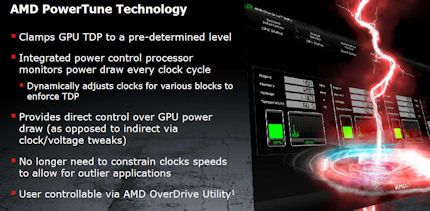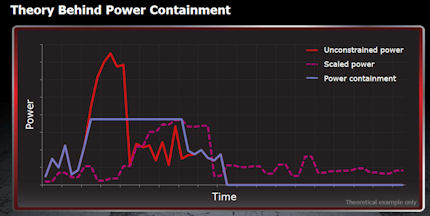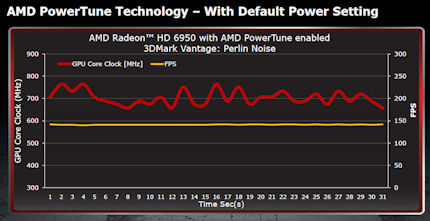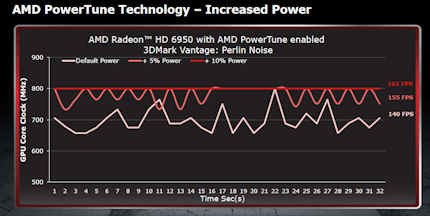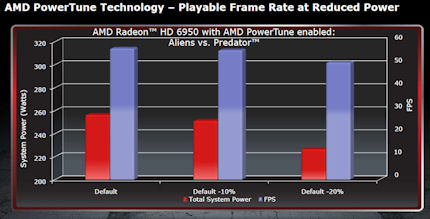PowerTune - something new
Controlling the power
Cayman represents the high-end of AMD's consumer graphics-card line-up. This implies that they're designed for performance, with board power of secondary concern. AMD, however, wants to inextricably tie power and performance together through its PowerTune technology.
The purpose of PowerTune is to dictate the GPU's performance via power. Read that sentence again and you'll realise it's a genuine shift away from how present GPUs are designed, where performance dictates power.
Hardware-based control
Cayman is outfitted with sensors that monitor the exact power-draw consumed by the card. This is completely driver-independent and fully hardware-based. Radeon HD 6970/50 ship with particular TDPs (thermal power) ratings and PowerTune ensures that they're not breached by any application.
The point here is that it's all about board power and how best to manage it without going over the rating at any time.
This slide shows an exaggerated case of power-draw when running a GPU-bustin' application. The red line indicates unconstrained power, as it is on all current Radeon cards, where it can jump to way beyond the TDP for short-ish periods of intense load. Apps such as FurMark and OCCT can produce this kind of effect.
Clocking down
The purple line shows PowerTune-scaled power, where it's never above the rated TDP. In extreme cases, the GPU automatically clocks down to avoid hitting the TDP ceiling, but then runs close to TDP as the load decreases. The net results, AMD says, is overall performance which is very similar to unconstrained power yet delivered in a smoother flow.
AMD reckons that no present game is able to breach the Cayman's TDP settings, kind of making PowerTune moot for now, though future games engines may well push cards above the rating. 3DMark Vantage's Perlin Noise test is a borderline case - stressful enough to ramp TDP to above-specified levels for short periods.
You can see that PowerTune dynamically adjusts the GPU clock according to TDP load, reducing speeds when it's just above, to keep the board's power in check. Performance, though, barely fluctuates throughout.
Slider-bar for the enthusiast
The enthusiast in you may not want to have any clock-speed reduction happening without your knowledge. In this case, AMD will offer a slider-bar in the control panel that either reduces or raises the board's power by up to 20 per cent. Here's the same 3DMark test with power increased by five and 10 per cent over default. Note how performance goes up?
Here's a demonstration of the slider-bar in action, running the Aliens vs. Predator benchmark. The test system pulls around 250W at default. Scaling the GPU power down by 10 per cent, via the control panel, reduces power-draw but has a negligible impact on performance. Reducing it by a further 10 per cent brings down system load by 30W and game performance by around 10 per cent.
Power controls performance
We see PowerTune as means of adjusting power to control performance. AMD can clamp the power to a certain TDP and control the board's speed, though the slider-bar mitigates performance loss, if increased by the end-user.
We reckon that PowerTune is really designed with the OEM PC builders in mind. They want assurances that a GPU, or two in CrossFireX, won't trip up the system if running, say, FurMark. Heck, if Dell supplies a 500W PSU with a Radeon HD 6870-based PC it wants guarantees that the system won't keel over in extreme-load cases. PowerTune enables this on high-end cards, where watts can quickly spiral out of control.
It's a little difficult to get your head around power controlling performance, but we reckon this is how all future GPUs will be designed. Even NVIDIA has taken the same tack with its own power containment technology on the GeForce GTX 580/570 GPUs.
Summing up the architecture
We've brought you this far without mentioning any HD 6970/50 specifics. Don't worry, the next page will be full of numbers. What you need to know about the Cayman architecture, with due reference to last generation's Cypress, is that it has:
Substantially improved geometry throughput
Revised core setup; now (slightly) more efficient with a 4D arrangement
Enhanced GPGPU design; faster double-precision calculations
Better image-quality settings through EQAA
PowerTune technology, stopping the GPU from going above TDPs
There are a myriad of other minor changes that are outside the remit of this review, but the five takeaways should suffice as a grounding of what to expect from Cayman.






